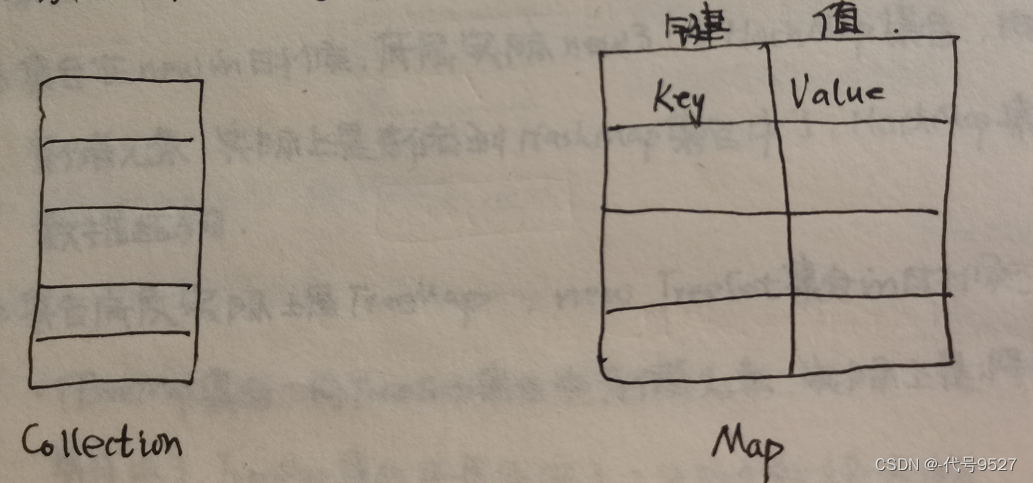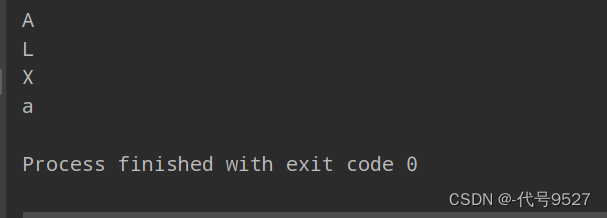-
【Java进阶篇】第五章 集合(上)--Collection集合
一、集合概述
集合实际可理解成是一个容器,可以用来容纳其他类型的数据,数组其实就是一个集合。
集合做为一个载体,在实际开发中,将从数据库中查询到的多条数据封装成多个对象,并将他们通过集合传到前端,然后遍历集合,展现数据。

集合不能直接存储基本数据类型,也不能直接存储Java对象,集合当中存储的都是Java对象的内存地址(引用)。
1、集合与数据结构
不同的集合对应不同的数据结构,在Java中,每一个不同类型的集合,底层会对应不同的数据结构,往不同的集合中存储元素,等于将数据放到了不同的数据结构当中。
这里的数据结构,即数据存储的结构,不同的数据结构,数据存储方式不同。如:
- 数组
- 二叉树
- 链表
- 哈希表
- 图
new不同的集合对象,底层使用不同的数据结构:
//该集合底层为数组 new ArrayList(); //该集合对象底层是链表 new LinkedList(); //该集合对象底层是二叉树 new TreeSet();- 1
- 2
- 3
- 4
- 5
- 6
- 7
- 8
- 9
2、集合的分类
所有的集合类和集合接口都在JDK的java.util包下。集合在Java中分为两大类:
- 单方式存储元素,这一类集合中的超级父类接口为java.util.Collection
- 以键值对的方式存储元素,此类集合中超级父类接口为java.util.Map

3、Collection集合继承结构图(接口)
Collection之List集合的特点:
- List集合存储的元素有序可重复,元素有下标,下标从0开始
- 有序指的是存进去是这个顺序,取出来还是这个顺序,和元素大小无关。
Collection之Set集合的特点:
- Set集合存储的元素无序不可重复,且无下标
- 无序指的是存进去是这个顺序,取出来就不一定是这个顺序了。

- ArrayList集合底层采用了数组的数据结构(非线程安全)
- LinkedList集合底层采用了双向链表的数据结构
- Vector集合采用了数组的数据结构,且有synchronized关键字修饰,是线程安全的,但Vector的效率较低
- HashSet集合在new的时候,底层实际new了一个HashMap集合,向HashSet集合中存储元素,实际是存储到了HashMap集合中了。HashMap集合是一个哈希表数据结构
- TreeSet集合底层实际是TreeMap,new TreeSet集合的时候,底层实际new了一个TreeMap集合。向TreeSet集合中存储元素,实际是将数据放到TreeMap集合中了,TreeMap集合底层采用了二叉树的数据结构。
4、Map集合继承结构图
- Map集合和Collection集合没关系
- Map集合以key和value这种键值对的方式存储元素,key和value都是存储Java对象的内存地址
- Map集合的key都是无序不可重复

HashMap和Hashtable集合底层都是哈希表数据结构,但前者非线程安全。Hashtable类中的所有方法均带synchronized,线程安全,但效率低。
- Properties继承Hashtable,线程安全,以key-value的形式存储元素(Map集合的特点),且key和value只支持String类型。Properties被称为属性类。
- TreeMap集合底层的数据结构是二叉树
5、Collection接口中的方法
Collection中能存放什么元素? -------- 没有使用泛型之前,可存储Object的所有子类型 使用泛型之后,只能存储某个具体的类型- 1
- 2
- 3
- 4
1)😉 boolean add (Object e)方法
//Collection是一个接口,无法实例化 Collection c = new Collection(); //多态 Collection c = new ArrayList(); //集合中只存Java对象的内存地址,此处是自动装箱后放进去了对象的内存地址。 c.add(1200); c.add(new Object()); //自动装箱 c.add(true);- 1
- 2
- 3
- 4
- 5
- 6
- 7
- 8
- 9
2)😉 int size()方法
System.out.println("集合中的元素个数是:"+c.size());- 1
3)😉 void clear()方法
c.clear();- 1
4)😉 boolean remove(Object o)方法
//删除某个元素 c.remove(true);- 1
- 2
5)😉 boolean contains(Object o)方法
//判断当前集合中是否包含元素o boolean query = c.contains("hello");- 1
- 2
- 3
6)😉 boolean isEmpty()方法
//判断集合中元素个数是否为0 System.out.println( c.isEmpty() );- 1
- 2
7)😉 Object[] toArray()方法
//集合转数组 Object[] objs = c.toArray();- 1
- 2
- 3
6、Collection集合的迭代
注意是Collection集合的迭代,在Map集合中不能用。
import java.util.ArrayList; import java.util.Collection; import java.util.Iterator; public class Collection1 { public static void main(String[] args) { Collection c = new ArrayList(); c.add(1200); c.add(new Object()); c.add(true); c.add("code-9527"); System.out.println("集合中的元素个数是:"+c.size()); Iterator it = c.iterator(); //当有下一个元素的时候 while(it.hasNext()){ //取出下一个元素 Object obj = it.next(); System.out.println(obj); } } }- 1
- 2
- 3
- 4
- 5
- 6
- 7
- 8
- 9
- 10
- 11
- 12
- 13
- 14
- 15
- 16
- 17
- 18
- 19
- 20
- 21
- 22
- 23
- 24
步骤:
- 获取集合对象的迭代器对象
Iterator it = c.iterator();- 1
- 通过迭代器对象开始遍历集合
//迭代器对象可以调用两个方法: boolean hasNext() 如果仍有元素可以迭代,则返回true Object next() 返回迭代的下一个元素- 1
- 2
- 3
- 4
- 5
- 6

二、Collection的工具类
1、contains方法深入
Collection c = new ArrayList(); String s1 = new String("abc"); c.add(s1); c.add(new String("def")); String s2 = new String("abc"); //true System.out.println(c.contains(s2));- 1
- 2
- 3
- 4
- 5
- 6
- 7
- 8

结果分析:
contains方法底层源码中调用了equals,而String类的equals是重写成了比较对象的内容。这时候的contains就像在中国找小明,不管你是住河北的小明,还是住河南的小明。即不管内存地址是啥,String对象内容相同就当是包含。2、remove方法深入
Collection c = new ArrayList(); String s1 = new String("code-9527"); c.add(s1); String s2 = new String("code-9527"); c.remove(s2); //0 System.out.println(c.size());- 1
- 2
- 3
- 4
- 5
- 6
- 7
remove方法底层也调用了equals方法,而String类的equals方法已经重写成了比较对象内容,所以传入s2可以将内容相同的s1去除。(若不是String类,是另一个没有重写equals的类,则没有这个效果)
3、集合结构只要发生改变,迭代器必须重新获取
Collection c = new ArrayList(); Iterator it = c.iterator(); //获取迭代器对象后,集合结构发生变更 c.add(1);//Integer c.add(2); while(it.hasNext()){ //next()方法的返回值类型必须是Object(不考虑泛型) Object obj = it.next(); System.out.println(obj); }- 1
- 2
- 3
- 4
- 5
- 6
- 7
- 8
- 9
- 10
运行报错:
当集合结构发生变化,迭代器对象没有获取最新的时候,调用next()方法报错java.util.ConcurrentModificationException

Iterator it = c.iterator();获取迭代器对象,相当于给当前集合的状态打了一个快照,当底层代码运行时,会将快照与实际的集合状态进行对比
而用迭代器.remove() 删除元素,迭代器和集合中的元素都会放生变化,二者保持一致,就不会有java.util.ConcurrentModificationException错误。用集合.remove() 只是删除了集合中的元素。
Collection c = new ArrayList(); Iterator iterator = c.iterator(); while(iterator.hasNext()){ Object o = iterator.next(); //集合.remove() //c.remove(o); //改为迭代器.remove iterator.remove(); System.out.println(o); }- 1
- 2
- 3
- 4
- 5
- 6
- 7
- 8
- 9
- 10
- 11
三、List接口特有的方法
上面是Collection类中的一些方法,List接口除了从父接口collection中继承的方法,还有其特有的方法,和Set接口没关系。
1、List接口特有方法
List集合存储元素的特点是: 有序可重复,即List集合中的元素有下标,从0开始- 1
- 2
- 😉 void add(int index ,Object element)方法
//new LinkedList() //new Vector() List myList = new ArrayList(); myList.add("a"); myList.add("b"); myList.add(1,"code-9527");- 1
- 2
- 3
- 4
- 5
- 6
- 😉 Object get(int index)方法
除了Collection公共的迭代器遍历,List有其特有的下标遍历
//根据下标取元素 for(int i=0;i<myList.size();i++){ System.out.println(myList.get(i)); }- 1
- 2
- 3
- 4
- 5
- 6
- 😉 int indexOf(Object o)方法
//获取指定对象第一次出现处的索引 //相对应的获取最后一次出现的索引: //int lastIndexOf(Object o) return myList.indexOf("aaa");- 1
- 2
- 3
- 4
- 5
- 😉 Object remove(int index)方法
//根据下标删除元素 myList.remove(0);- 1
- 2
- 😉 Object set (int index, Object newElement)方法
//修改指定位置的元素 myList.set(2,"new");- 1
- 2
2、List—ArrayList集合
- ArrayList集合初始化容量是10(底层先是建立一个长为0的数组,当添加第一个元素的时候,初始化容量为10)
//默认,容量为10 List list1 = new ArrayList(); //选择ArrayList的有参构造方法 //指定初始化容量为20 List list2 = new ArrayList(20); //注意,size方法获取的是元素个数,不是集合容量 list1.size();- 1
- 2
- 3
- 4
- 5
- 6
- 7
- 8
- 9
- ArrayList集合底层是一个Object[] 数组,每次扩容为原来的1.5倍容量。给定一个合理的初始化大小,可以减少ArrayList集合的扩容次数
- ArrayList的特殊构造方法
Collection c = new HashSet(); c.add("9527"); //通过这个构造方法,将HashSet转成ArrayList List list = new ArrayList(c);- 1
- 2
- 3
- 4
- 5
总结:
ArrayList集合用的最多,虽然随机增删元素效率较低,但常在末尾,效率不受影响,且查找效率高。最后,ArrayList集合是非线程安全的。位运算符复习:

3、List—LinkedList集合
😉 对于链表数据结构来说,基本单元是节点Node,对于单向链表来说,任何一个节点都有两个属性,一个是存储数据,一个是存储下一个节点的内存地址。

public class Node{ //存储的数据 Object data; //下一个节点的内存地址 Node next; public Node(){ } ...- 1
- 2
- 3
- 4
- 5
- 6
- 7
- 8
由图,链表的优点是:随机增删元素效率较高(不涉及大量元素的位移)。缺点是:查询效率较低,每一次查找某个元素的时候都需要从头节点开始往下遍历
😉 LinkedList集合属于List集合,也是有下标的,可以下标遍历,但是查询效率不高(ArrayList是底层是个数组的原因,有无下标和查询效率没有必然的联系),这是因为链表中的元素在空间存储上内存地址不连续,不能通过简单的数学表达式就计算出被查找元素的内存地址。
ArrayList把检索发挥到了极致,LinkedList把随机增删发挥到了极致
//递归查找末尾节点 //一个几点的next为空,则为末尾节点 private Node findLast(Node node){ if(node.next == null){ return node; } return findLast(node.next);- 1
- 2
- 3
- 4
- 5
- 6
- 7
- 8
😉 双向链表
双向链表的基本单元还是节点Node

LinkedList集合总结:- LinkedList集合底层采用了双向链表的数据结构
- LinkedList集合随机增删效率较高,检索效率较低
- LinkedList集合中的元素,在空间存储上内存地址不连续
4、List—Vector集合
Vector vector = new Vector(); List vector = new Vector();- 1
- 2
- Vector集合底层也是一个数组,初始化容量为10
- 集合满了以后扩容,每次为原容量的2倍,10、20、40、80…
- Vector中的所有方法都是线程同步的,都带有synchronized关键字,是线程安全的,效率低,使用较少。
- 使用集合工具类,将一个线程不安全的ArrayList集合转换成线程安全的
//非线程安全的 List myList = new ArrayList(); myList.add(1); //调用synchronizedList方法,变成线程安全的 Collections.synchronizedList(myList);- 1
- 2
- 3
- 4
- 5
- 6
注意:
java.util.Collection 是集合接口
java.util.Collections 是集合工具类四、泛型机制
1、泛型
- 在JDK5.0之后的新特性–泛型
- 泛型这种语法机制,只在程序编译阶段起作用,只是给编译器参考的,运行阶段泛型没用
- 泛型的优点是:集合中存储的元素类型统一,从集合中取出的元素类型是泛型指定的类型,不需要进行大量的向下转型
- 泛型的缺点是:导致集合中存储的元素缺乏多样性,但日常开发中类型统一,所以泛型应用较多)
2、泛型使用举例
//素材 class Animal{ public void move(){ System.out.println("动物在移动"); } } class Cat extends Animal{ public void move(){ System.out.println("猫抓老鼠"); } } class Birds extends Animal{ public void move(){ System.out.println("鸟在飞"); } }- 1
- 2
- 3
- 4
- 5
- 6
- 7
- 8
- 9
- 10
- 11
- 12
- 13
- 14
- 15
- 16
不使用泛型:
List myList = new ArrayList(); Animal c = new Cat(); Animal b = new Birds(); myList.add(c); myList.add(b); Iterator iterator = myList.iterator(); while(iterator.hasNext()){ //没使用泛型前,这里返回类型只能是Object Object obj = iterator.next(); //但Object类中没有move方法 //obj.move();报错 //需要频繁进行向下转型 if(obj instanceof Animal){ Animal animal = (Animal)obj; animal.move(); } }- 1
- 2
- 3
- 4
- 5
- 6
- 7
- 8
- 9
- 10
- 11
- 12
- 13
- 14
- 15
- 16
- 17
- 18
- 19
使用泛型之后:(用泛型来指定集合中存储元素的类型)
//使用泛型List即表示这个List集合中只允许存储Animal类型的数据 List<Animal> myList = new ArrayList<Animal>(); //myList.add("abc");传入String类型此时就error Cat c = new Cat(); Birds b = new Birds(); myList.add(c); myList.add(b); //即迭代器类型是Animal类型 Iterator<Animal> iterator = myList.iterator(); while(iterator.hasNext()){ //此时next()方法的返回值类型就是Animal Animal obj = iterator.next(); //这里也就不用向下转型了 obj.move(); }- 1
- 2
- 3
- 4
- 5
- 6
- 7
- 8
- 9
- 10
- 11
- 12
- 13
- 14
- 15
- 16
但这里如果要继续调用Animal子类的特有方法,也得向下转型:
Iterator<Animal> iterator = myList.iterator(); while(iterator.hasNext()){ Animal obj = iterator.next(); obj.move(); //访问子类特有的方法 if(obj instanceof Cat){ Cat cat = (Cat)obj; cat.catchMouse(); } if(obj instanceof Birds){ Birds birds = (Birds)obj; birds.fly(); } }- 1
- 2
- 3
- 4
- 5
- 6
- 7
- 8
- 9
- 10
- 11
- 12
- 13
- 14
- 15
3、自动类型推断机制(又称钻石表达式,JDK8之后)
List<Animal> myList = new ArrayList<Animal>();- 1
使用自动类型推断机制后,可写成:
List<Animal> myList = new ArrayList<>();- 1
4、自定义泛型
//这里的中的T是标识符,随便写,但 public class GenericTest<T>{ public void doSome(T x){ System.out.println(x); } public static void main(String[] args) { GenericTest<String> g1 = new GenericTest<>(); g1.doSome("code"); GenericTest<Integer> g2 = new GenericTest<>(); g2.doSome(9527); //写了泛型而不用,那就是Object类型 GenericTest g3 = new GenericTest(); //这里传参是Object类型 g3.doSome(); } }和 常用些 - 1
- 2
- 3
- 4
- 5
- 6
- 7
- 8
- 9
- 10
- 11
- 12
- 13
- 14
- 15
- 16
- 17
- 18
- 19
5、增强for循环—foreach
增强for循环不涉及下标,对无下标场景的遍历很实用
语法: for(元素类型 变量名:数组或者集合){ .... }- 1
- 2
- 3
- 4
举例:
int[] array = {96,97,98,99}; //普通股for循环遍历 for(int i=0;i<array.length;i++){ System.out.println(array[i]); } //增强for循环 for(int data:array){ System.out.println(data); }- 1
- 2
- 3
- 4
- 5
- 6
- 7
- 8
- 9
- 10
List集合的三种遍历:
List<String> myList = new ArrayList<>(); myList.add("code"); myList.add("-9529"); myList.add("Fight!"); //迭代器遍历 Iterator<String> iterator = myList.iterator(); while(iterator.hasNext()){ System.out.println(iterator.next()); } //下标遍历 for(int i=0;i<myList.size();i++){ System.out.println(myList.get(i)); } //增强for循环遍历 for(String s:myList){ System.out.println(s); }- 1
- 2
- 3
- 4
- 5
- 6
- 7
- 8
- 9
- 10
- 11
- 12
- 13
- 14
- 15
- 16
- 17
- 18
- 19
五、Set接口
1、HashSet集合
特点:
- 无序:存储时和取出来时的顺序不同
- 不可重复
- 放到HashSet集合种的元素实际时放到HashMap集合的key部分了
Set<String> mySet = new HashSet<>(); mySet.add("code1"); mySet.add("code2"); mySet.add("code3"); mySet.add("code1"); mySet.add("code1"); for(String str:mySet){ System.out.println(str); }- 1
- 2
- 3
- 4
- 5
- 6
- 7
- 8
- 9
运行结果:

2、TreeSet集合
- 无序不可重复,但是存储的元素可以自动按照大小顺序排序,称为可排序集合
- 无序指的是存进去和取出来的顺序不同,并且没有下标
myTreeSet.add("A"); myTreeSet.add("X"); myTreeSet.add("a"); myTreeSet.add("L"); for(String s:myTreeSet){ System.out.println(s); }- 1
- 2
- 3
- 4
- 5
- 6
- 7
运行结果:

-
相关阅读:
智慧风电 | 图扑软件数字孪生风机设备,3D 可视化智能运维
软考高级系统架构设计师系列之:快速掌握数据库系统核心知识点
kubernetes 高可用集群
Vue---反向传值
C语言常考面试基础问题
3. Exchange 交换机的使用
offline 2 online | AWAC:基于 AWR 的 policy update + online 补充数据集
神经网络如何识别图像,神经网络和图神经网络
Spring系列五:Spring怎么解决循环依赖
2022年最新海南水利水电施工安全员模拟试题题库及答案
- 原文地址:https://blog.csdn.net/llg___/article/details/127951659
